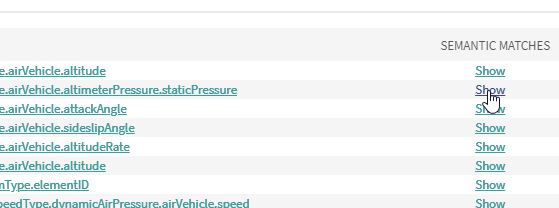Semantic Matches: Difference between revisions
| Line 4: | Line 4: | ||
The semantic match dialog in PHENOM lists perfect and approximate semantic matches of a given view attribute and gives a relative evaluation of match strength: | The semantic match dialog in PHENOM lists perfect and approximate semantic matches of a given view attribute and gives a relative evaluation of match strength: | ||
* Above the table headers, the user can see the characteristics of the selected View Attribute | * Above the table headers, the user can see the characteristics of the selected View Attribute | ||
* A filter box | * A filter box to filter the View column | ||
* Each match and its attributes | * Each match and its attributes show up as clickable links sorted by match strength | ||
[[File:Phenom-data model details semantic matches dialog.png|border]] | [[File:Phenom-data model details semantic matches dialog.png|border]] | ||
Latest revision as of 16:33, 26 September 2022
Purpose of Semantic Matching
When creating a View Attribute, which is meant to represent a piece of data about a system, PHENOM allows users to create a path which associates with the view attribute to document the meaning of the contained data. This path is written in terms of Entities, Associations, Observables, and the relationships between them and constructed in the conceptual layer (CDM) of the Domain Specific Data Model (DSDM). (For a more detailed review of creating a path using PHENOM, refer to the View Attributes page. For a more thorough discussion of how meaning is imbued in view attribute paths and the rational behind their construction, review the interface documentation tutorial.) When the paths of two different view attributes are identical (or at least similar), the implication becomes that the data contained within them represents the same thing. Even if view attributes represent data measured in different units or against different coordinate systems, or sent using different primitive values, because the paths in PHENOM are documented in terms of conceptual level entities, we can determine when the meaning of the data is identical even if a transformation may have to be performed to reconcile the differences on the logical and/or platform levels.
The semantic match dialog in PHENOM lists perfect and approximate semantic matches of a given view attribute and gives a relative evaluation of match strength:
- Above the table headers, the user can see the characteristics of the selected View Attribute
- A filter box to filter the View column
- Each match and its attributes show up as clickable links sorted by match strength
Viewing Semantic Matches
There are two places in PHENOM where the semantic match dialog can be accessed. The first is a View's details page. Each row of a view's attributes table contains a "Show" link in the "Semantic Matches" column. Clicking this link will bring up the semantic matches dialog.
The second is the View Trace page. After a view has been added to the diagram, clicking on an attribute's name will bring up the semantic matches dialog.
Use of Semantic Matches in PHENOM
Semantic matches are the basis for drawing the connecting bands between view attributes on the Meridian Map. Perfect semantic matches are also what is used to automatically determine mappings between attributes of different views in the View Trace, though partial matches can be manually reviewed to create mapping of attributes with only similar paths.


